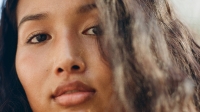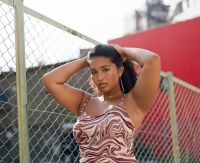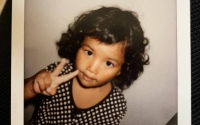In the spring of last year, 24-year-old Japanese model Dulmi suddenly found herself on a plane to London — her first solo trip overseas.
Upon arriving at her hotel in the British capital, she answered a phone call requesting that she make her way to the historic and soon-to-close Vogue House, where supermodels, royals and Hollywood stars have walked the halls.
Dulmi beamed as she told the story.
“After 24 hours of travel, I was so exhausted, but I jumped in the shower and then into an Uber they sent,” she said. “At Vogue House, I was suddenly in a conference room where they set out all these extremely stylish, luxury outfits and accessories in front of me.”
The next day, she was surrounded by the fashion magazine’s makeup and nail artists, stylists, photographers and editors, all of whom ultimately styled and chose the one photo of her that would announce her winning spot in the 2023 class of Vogue’s Open Casting initiative.
Started in 2022, Open Casting is a “global modeling initiative aimed at discovering new archetypes and new personalities that reflect the world we live in.” Dulmi was one of just eight models chosen out of 60,000-plus applicants, and alongside her were those hailing from South Africa, Britain, the United States, France, Morocco, China and Ghana.
“Everyone was just so beautiful, I was so happy to meet them all,” Dulmi said.
In the photo published both in the magazine and online, under the words “Dulmi, Tokyo, Japan,” the model leans against the backside of her chair with her left arm — her bright red nails pop, and she sports an exquisite floor-length, black leather trench coat, which she said was carefully picked by Vogue’s team.
Her black hair is parted on the side and slicked back into a low bun, leaving ample space for her warm, almond-toned skin and high cheekbones to glow in a natural makeup look. The photograph looks like that of a painted portrait of royalty.
“Originally, I had a different outfit on, but when the photographer put her camera up to her eye, she felt that wasn’t the right look for me,” Dulmi said. “I think we changed the outfit about three times.”
And the makeup they tried was so new for her. She later told Vogue Japan that the styling made her feel like she was “meeting a new her.”
“Everything was just so special,” she told The Japan Times.
In her class of models, Dulmi is the only one representing Japan, and her presence on the list represents a break from the norms of the modeling industry, especially those of Japan's.
In addition to being the only curvy model on the list, she is also biracial — and is vocal about being proudly both. But Vogue's spotlight on her and her natural qualities is a still-rare recognition of the diversity that exists in Japan, with this tending to be overlooked by both the domestic and international modeling industries.
Born in Osaka to a Japanese mother and a Sri Lankan father, Ayano Dulmi Obata — Dulmi's full name — was predominantly raised in Tokyo and went through every stage of Japan's compulsory education system. At each step, she knew she looked different from the children around her, with a darker skin tone and a body that was always more muscular than other girls.
Plus, while she hadn’t met her father, she knew he was Sri Lankan, while everyone around her came from two Japanese parents.
“I grew up in Japanese culture and felt like I had the heart of a Japanese person,” she said. “But, because I looked different, others saw me as a foreigner or mixed.
“So I had complex feelings during my childhood, but because I was an extremely lively and active child, I was always challenging myself and was a proactive kid that wanted to do everything ... so I didn’t really let myself form negative thoughts about that stuff.”
That lively child, according to Dulmi, always had confidence and a natural desire to be the lead — like when she became her high school’s student council president — which is why her ultimate dream was always to be an actress or model.
Still, she had the feeling that that dream wasn't achievable.
“The models and actresses we see featured on TV, in magazines or in ads in Japan, they didn't look like me,” Dulmi said. “I was more tan, and most (models) were slender.”
Diverse representation in Japan’s beauty norms was and continues to be limited, except maybe for longtime model Rola, who is of Japanese, Bangladeshi and Russian descent. While a wide spectrum of multiracial people exists in Japan, the multiracial models who have tended to grace the covers of Japan's most popular magazines have always been half-white or white-passing, and curvy or plus-size models are still few and far between.
“I’d half given up,” Dulmi said.
However, it was her mother's push for her to apply to model for Japanese lingerie brand Peach John‘s “real-size model” campaign in 2020 that put Dulmi on her present path.
Her mother had always been a source of encouragement, reassuring her that she could accomplish anything because of who she is and that there was nothing about her that put her at a disadvantage compared with other kids.
Dulmi ultimately got the Peach John job, catapulting her into the modeling industry at age 20. The combination of the campaign — which showed her true skin tone and shape — and a later run to become a Miss Universe Japan finalist in 2021 told her that she could craft a unique niche for herself in the industry — not only as a model, but an advocate too.
“I wanted to do it differently, and I wanted to send a message,” she said. “In Miss Universe Japan, I didn’t conform. ... I didn’t diet or restrict myself and stuck to increasing exercise. ... So while I did hear questions of 'Why aren’t you losing weight?' I rebelled a bit and still became a finalist.
“I’ve received courage from many people who sent in supportive comments and spoke of wanting to live their lives confidently. ... Those who supported me found meaning in my presence in Miss Universe Japan, and I saw that I could encourage them by just being myself.”
Dulmi signed with Pump Management in February and is now one of a handful of nonwhite, multiracial people backed by the Tokyo-based talent agency, whose mission includes widening “the standards and concept of beauty from within Tokyo." And while the path to signing with an agency wasn’t easy, Dulmi says it was her unwillingness to take “no” or “maybe” for an answer that ultimately got her a place on the roster of a company she admired.
“I applied to about 10 modeling agencies, and most were unsuccessful,” she said. “But I happened to meet the president (of Pump) by chance, and while at the time I was a freelance model, she asked me to come to the agency to at least take photos for freelance work.
“But I felt like I had no choice but to be direct and told her, 'I don’t just want to be a freelancer, I want to be signed.'”
Her strategy worked.
Now, especially with Dulmi’s recent win, the agency is excited to continue uplifting Dulmi’s image, voice and humanity.
The team helps her cut through the noise, particularly the labeling and categorization that can arise in the industry, often during the audition process. They also help handle companies who might not want to take much risk in presenting a diversity of appearance.
“Something that really bothered me during my freelancing period was the categories we’re divided into — oftentimes only Asian, Black and white,” Dulmi said. “I often fell into the Black category because Japanese people are looking for the (East Asian) archetype, but I shouldn't fit in the Black category.
“So it felt troubling to not fit anywhere. ... But that feeling has now disappeared.”
Her agency supported her when she came to them with the desire to apply to Vogue's Open Casting.
Now, the recognition by Vogue has reinforced to Dulmi the importance of her role as such a unique model in Japan.
”Getting Vogue was confirmation that I’ve been doing the right thing up until now and that my message was conveyed not only in Japan but also across the globe,” she said.
“I feel like this is just the starting point, not the end goal.”
Dulmi who only became a full-time model three months ago, plans to carry that mindset from here on out.
As she takes on more work and moves toward her dream of achieving a similar status to and working with some of today’s most renowned curvy supermodels, such as Paloma or Ashley Graham, she hopes to be a voice for change in Japan, a society where it can be difficult to speak up against cultural norms.
“Personally, I lacked self-confidence in my appearance as a child, and everything we see as children influences us,” she said. “If our generation doesn't change, the younger ones won’t either, so it’s not just about educating children, it’s about educating adults too.
“There are so many different kinds of people in the world and I want society to accept that. ... I want everyone to love themselves as they are.”






















With your current subscription plan you can comment on stories. However, before writing your first comment, please create a display name in the Profile section of your subscriber account page.